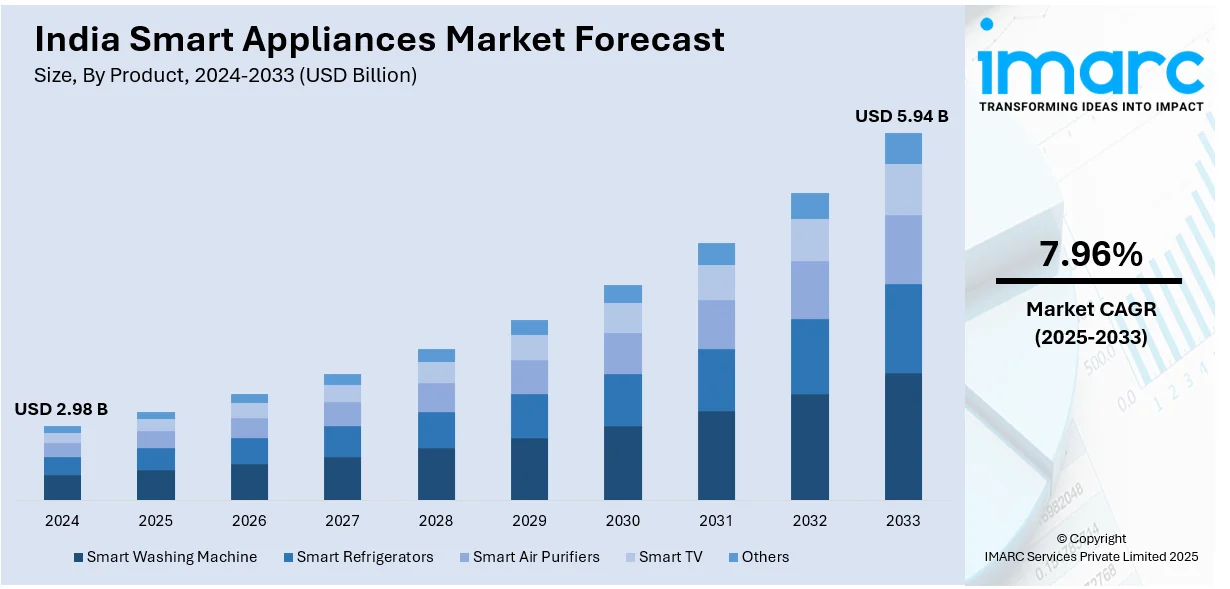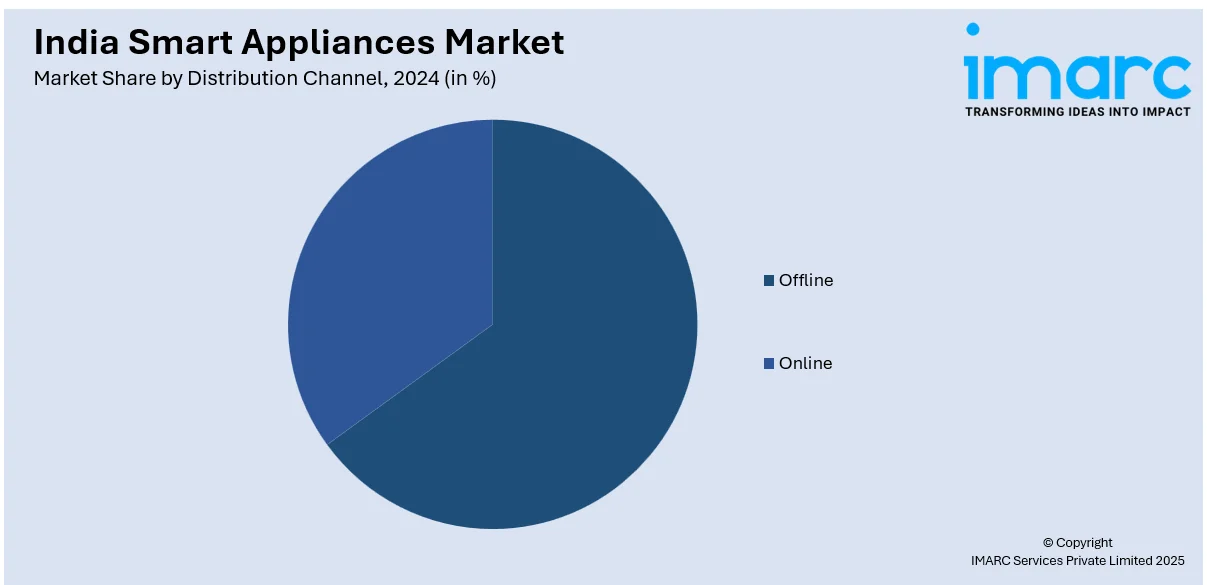
India Smart Appliances Market Size, Share, Trends and Forecast by Product, Technology, Distribution Channel, End-User, and Region, 2025-2033
India Smart Appliances Market Overview:
The India smart appliances market size reached USD 2.98 Billion in 2024. Looking forward, IMARC Group expects the market to reach USD 5.94 Billion by 2033, exhibiting a growth rate (CAGR) of 7.96% during 2025-2033. Expanding e-commerce and rising internet penetration are driving the India smart appliances market share. Additionally, government initiatives promoting energy efficiency further support the market growth across urban and rural areas.
|
Report Attribute
|
Key Statistics
|
|---|---|
|
Base Year
|
2024 |
|
Forecast Years
|
2025-2033
|
|
Historical Years
|
2019-2024
|
| Market Size in 2024 | USD 2.98 Billion |
| Market Forecast in 2033 | USD 5.94 Billion |
| Market Growth Rate 2025-2033 | 7.96% |
India Smart Appliances Market Trends:
Growing e-commerce and retail channels
Expanding e-commerce and retail channels are driving the India smart appliances market outlook by increasing product accessibility. The Indian e-commerce market is expected to grow from US$ 123 billion in 2024 to US$ 292.3 billion by 2028, registering a CAGR of 18.7%, fueling smart appliance adoption. Online platforms are offering diverse smart appliances with competitive pricing, attracting cost-conscious and tech-savvy buyers. Retailers are integrating omnichannel strategies, allowing customers to browse online and purchase through preferred channels. Widespread internet penetration is enabling seamless digital transactions, simplifying the smart appliance buying process for Indian customers. E-commerce giants are collaborating with smart appliance brands, providing exclusive deals, discounts, and easy financing options. Online marketplaces are leveraging AI-driven recommendations, helping shoppers find relevant smart appliances based on preferences. Fast-growing quick-commerce platforms are reducing delivery times, ensuring faster access to smart appliances in urban areas. Expanding physical retail stores are offering hands-on product experiences, building customer trust in smart technology. As e-commerce continues its rapid growth, increasing accessibility and convenience are set to further accelerate the India smart appliances market growth.

Increasing internet penetration
The growing internet penetration is fueling the India smart appliances market growth by enabling seamless connectivity and remote control. As per data published by PIB, total internet subscribers grew from 251.59 Billion in March 2014 to 954.40 Billion in March 2024, significantly expanding digital access. Widespread internet availability is allowing customers to integrate smart appliances into connected home ecosystems effortlessly. Increasing smartphone adoption is further enhancing accessibility, enabling users to control appliances through mobile applications conveniently. High-speed internet is improving smart appliance functionality, ensuring smooth operation of AI-driven and IoT-enabled devices. Expanding 5G networks are enhancing real-time connectivity, enabling faster communication between smart appliances and user interfaces. Rising broadband penetration in urban and rural areas is further extending smart appliance adoption across different customer segments. Online tutorials and digital marketing campaigns are generating awareness, educating people about smart appliance benefits. Cloud-based services are enhancing data storage and analytics, optimizing the efficiency of connected home appliances. As digital infrastructure strengthens further, the growing internet penetration is set to accelerate the smart appliances market in India significantly.
India Smart Appliances Market Segmentation:
IMARC Group provides an analysis of the key trends in each segment of the market, along with forecasts at the regional level for 2025-2033. Our report has categorized the market based on product, technology, distribution channel, and end-user.
Product Insights:
- Smart Washing Machine
- Smart Refrigerators
- Smart Air Purifiers
- Smart TV
- Others
The report has provided a detailed breakup and analysis of the market based on the products. This includes smart washing machine, smart refrigerators, smart air purifiers, smart TV, and others.
Technology Insights:
- Wi-Fi
- Bluetooth
- Near Field Communication (NFC)
- Others
A detailed breakup and analysis of the market based on the technology have also been provided in the report. This includes Wi-Fi, Bluetooth, near field communication (NFC), and others.
Distribution Channel Insights:

- Offline
- Online
The report has provided a detailed breakup and analysis of the market based on the distribution channel. This includes offline and online.
End-User Insights:
- Residential
- Commercial
A detailed breakup and analysis of the market based on the end-user have also been provided in the report. This includes residential and commercial.
Regional Insights:
- North India
- South India
- East India
- West India
The report has also provided a comprehensive analysis of all the major regional markets, which include North India, South India, East India, and West India.
Competitive Landscape:
The market research report has also provided a comprehensive analysis of the competitive landscape. Competitive analysis such as market structure, key player positioning, top winning strategies, competitive dashboard, and company evaluation quadrant has been covered in the report. Also, detailed profiles of all major companies have been provided.
India Smart Appliances Market News:
- In February 2025, Infinix introduced the 40Y1V QLED TV in India, featuring a 40-inch Full HD display with a 60Hz refresh rate and 300 nits peak brightness. Powered by a quad-core processor and Mali-G31 GPU, it includes 4GB of internal storage. With Dolby Audio and dual 16W stereo speakers, it comes preloaded with popular streaming apps.
- In February 2025, Circuit House Technologies, a consumer tech startup founded by former Xiaomi and Flipkart executives, launched Lumio, a smart TV brand focused on quality and innovation. Manufactured by Dixon Technologies and integrated with Google TV, it caters to India’s growing demand for premium home entertainment.
India Smart Appliances Market Report Coverage:
| Report Features | Details |
|---|---|
| Base Year of the Analysis | 2024 |
| Historical Period | 2019-2024 |
| Forecast Period | 2025-2033 |
| Units | Billion USD |
| Scope of the Report |
Exploration of Historical Trends and Market Outlook, Industry Catalysts and Challenges, Segment-Wise Historical and Future Market Assessment:
|
| Products Covered | Smart Washing Machine, Smart Refrigerators, Smart Air Purifiers, Smart TV, Others |
| Technologies Covered | Wi-Fi, Bluetooth, Near Field Communication (NFC), Others |
| Distribution Channels Covered | Offline, Online |
| End-Users Covered | Residential, Commercial |
| Regions Covered | North India, South India, East India, West India |
| Customization Scope | 10% Free Customization |
| Post-Sale Analyst Support | 10-12 Weeks |
| Delivery Format | PDF and Excel through Email (We can also provide the editable version of the report in PPT/Word format on special request) |
Key Questions Answered in This Report:
- How has the India smart appliances market performed so far and how will it perform in the coming years?
- What is the breakup of the India smart appliances market on the basis of product?
- What is the breakup of the India smart appliances market on the basis of technology?
- What is the breakup of the India smart appliances market on the basis of distribution channel?
- What is the breakup of the India smart appliances market on the basis of end-user?
- What are the various stages in the value chain of the India smart appliances market?
- What are the key driving factors and challenges in the India smart appliances market?
- What is the structure of the India smart appliances market and who are the key players?
- What is the degree of competition in the India smart appliances market?
Key Benefits for Stakeholders:
- IMARC’s industry report offers a comprehensive quantitative analysis of various market segments, historical and current market trends, market forecasts, and dynamics of the India smart appliances market from 2019-2033.
- The research report provides the latest information on the market drivers, challenges, and opportunities in the India smart appliances market.
- Porter's five forces analysis assist stakeholders in assessing the impact of new entrants, competitive rivalry, supplier power, buyer power, and the threat of substitution. It helps stakeholders to analyze the level of competition within the India smart appliances industry and its attractiveness.
- Competitive landscape allows stakeholders to understand their competitive environment and provides an insight into the current positions of key players in the market.
Need more help?
- Speak to our experienced analysts for insights on the current market scenarios.
- Include additional segments and countries to customize the report as per your requirement.
- Gain an unparalleled competitive advantage in your domain by understanding how to utilize the report and positively impacting your operations and revenue.
- For further assistance, please connect with our analysts.
 Inquire Before Buying
Inquire Before Buying
 Speak to an Analyst
Speak to an Analyst
 Request Brochure
Request Brochure
 Request Customization
Request Customization




.webp)




.webp)












